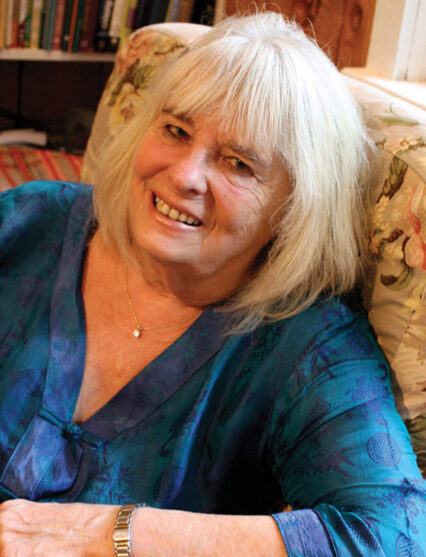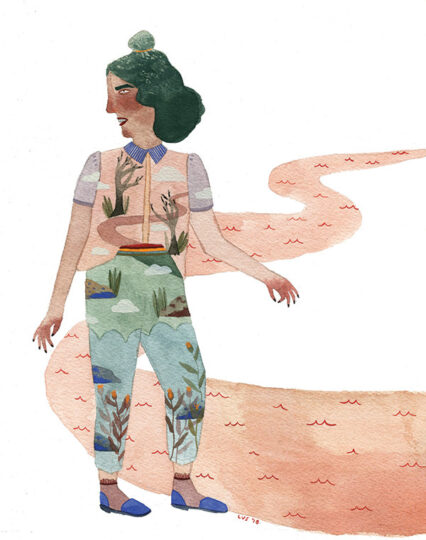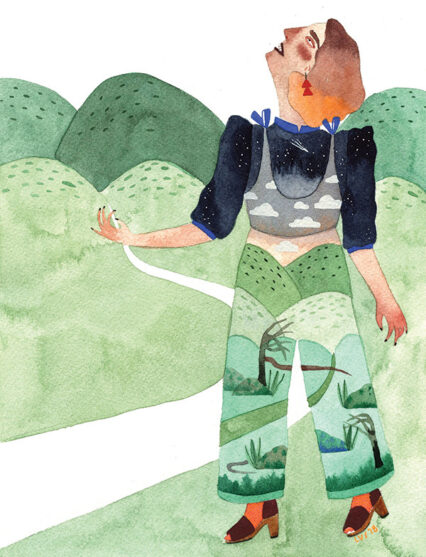Working to Stay Here
An Interview with Mirabai Bush
Landscape Lady #3 - Lindsay Stripling
Ram Dass is often in so much pain,” reports his longtime friend and coauthor, Mirabai Bush. “But he believes that nobody dies a moment before they should, a moment too soon or too late—that you have karma to fulfill. For Ram Dass, that means continuing to teach as he goes through the pain and discomfort and learns from it himself.” We spoke with Bush about the liberating conversations that formed their new book, Walking Each Other Home: Conversations on Loving and Dying.
Ram Dass talks about how, when sitting by the bedside of someone who is dying, he becomes a ‘loving rock.’ To not feel like you have to explain things, or find answers, or be busy. To just sit there and be loving and be present.
Ram Dass chose you to coauthor this book because of your comfort with silence. What does that mean?
There are so many ways to think about silence, of course. When we first started teaching retreats for social justice activists at the Center for Contemplative Mind, many people said, “I don’t want to do these meditation practices where you sit with your eyes closed and you’re silent, because I feel like I can’t be silent until I’ve been heard.”
This is different. For one thing, I knew Ram Dass has heard me over and over for many years. So I didn’t find myself saying things that I might have said to someone who I didn’t think had heard me yet. Also, because of his aphasia [resulting from his stroke 20 years ago], he creates silence, long pauses, while he tries to figure out how to express what he wants to say. I tried to get the spirit of that in the book. I didn’t feel I could write, 30 times, “a long pause.”
With Ram Dass it was a gift to sit there in silence. Then whatever he wanted to say would emerge into this space of stillness. So the words were like jewels, you know—really beautiful. Just being comfortable with silence is being comfortable with allowing things to be just what they are, which is the basic practice of meditation. Of just seeing things as they are, letting them be as they are. Of course, that doesn’t preclude wanting to change things in the world and in yourself that need to be changed, but in the moment, it’s being comfortable with exactly what is, and being receptive. Silence allows you to be receptive because you’re not busy talking. Silence allows you to listen deeply, and just be.
I teach deep listening. It’s done in pairs and the listener is instructed to be silent and listen to the person speaking, using what they are saying as their object of attention. When your attention wanders off, you bring it back to what the person is saying, over and over, just like in a mindfulness practice. After it’s over, the speaker will often say, “I’ve never been listened to that way. I could tell she was really listening to what I had to say.” And then the listener will say, “I’ve never listened in that way, because there’s always stuff going on in the mind and in the environment and always part of me wants to pay attention to it.” So bringing that silence and the qualities of silence into listening and speaking really enriches the conversation.
Ram Dass talks about how, when sitting by the bedside of someone who is dying, he becomes a “loving rock.” To not feel like you have to explain things, or find answers, or be busy. To just sit there and be loving and be present. Of course, you may be learning a lot from it. It’s not that there’s no content going on, but allowing yourself and the dying person to be together in loving silence is a great gift.

Isn’t that also the moment in which the person sitting by the bedside wants to do everything to prevent death?
Yes. And that’s why you need a practice. You need a practice in mindful listening and you need a practice for sitting by the bed. You’re not just hanging out. You’re there, and all these thoughts and memories and fears come into the mind. You just notice them. It’s good to notice them, especially in that context. If you’re being with a person who is dying, you’re likely going to be learning a lot about your own fears and your own ideas about death. But as these thoughts and emotions arise, you just notice them, and then let them go, and remind yourself you’re just there to be a loving rock.
People who read this book are going to have their own stuff come up, because it’s hard to sit there and be there for ourselves, too.
Aha! Yes! They will. Exactly. The intention is to learn what is going on inside you. So if you start reading about dying, then maybe emotions and fears will arise in you. That’s why we put 10 or 12 different practices in the book, so you can work with your fears, because they don’t usually fall away by themselves. So practice with them. Let them go.
I heard Paul McCartney talk about when his mother died and in a dream she told him to “let it be.” Sweet to know that’s where the song came from: Just let it be. That’s the meditation practice: to just see what is arising, to let it be and let it go, so that you can come back and pay attention—and maybe later, you will want to work with those fears that arise. Find a way, as Ram Dass says, to bring them close.
Did anything change for you?
I’ve been doing these practices for 45 years, and talked a lot about these things, and I’m getting old. When we started, I didn’t have a big pile of fears and regrets, but there were some. Engaging death by being in these conversations was helpful. It wasn’t the content so much; it was just bringing it close. Like holding death, and it just became more familiar and intimate and comfortable, and part of life, in a way.
Who knows what will arise when my time comes? If it were conscious now, I would probably let it go. Who knows what’s in the unconscious now? But, basically, I just feel so much easier with the reality of death, and so much easier with life. It’s interesting. Before, I felt my life was pretty mellow—I mean, I have all kinds of stuff going on in my life, but I’m basically a happy person, and I have learned many practices over the years. I have a good relationship and a good place to live and rest, but now I feel different. I feel . . . There is a kind of ease in knowing that death will come, and I’ll be sad, but it is OK. I think that’s about bringing it close. And that’s what Ram Dass says about fear. Hold it close and be intimate with it, so you can see what’s really there. What you really are afraid of. And, you know, it turns out that it’s pretty much mind-created.

You talk about Ram Dass’s comparison of death to “taking off a tight shoe”—that there would be some relief involved.
I think so. Taking off a tight body. You know, the design of this whole life is hard to understand. After working hard all life long, you ought to be comfortable at the end, your body should feel better, not worse, and yet you have all these aches and pains and complications. I actually had my annual physical in June and I’m in perfect health. That’s really awesome. But by and large it’s a drag getting old. I now think the reason for it, spiritually, is that you begin to be less attached to your body. You might be attached to the pain in the sense that you really hate it. But I think that after people live to a ripe old age, when they die, they are ready to go. It’s enough, already. So I realize that spiritually it’s a gift that the body begins to give out.
Ram Dass said that in the process of our conversations he got closer to death, not physically because it took us so long, but because he let go in the process of doing it. That was so touching, you know?
Could this book help us develop a different set of criteria for earlier in life?
Yes. Simplify! I am in the process of going through all the possessions of a close friend who died last winter. My friend had impeccable taste, and she had money. So everything she owned had some value and was beautiful, or precious, so we couldn’t just get rid of it. We had to go through it piece by piece and think about the right person who would love this. So simplify now. Live with less, and love more.
One thing that stuck out is the urging to love your past. All of it.
Yes. When asked about that, many people start crying. Forgiveness of ourselves is hard. Which isn’t to say we haven’t done some yucky things in our life—it’s not to say we’re so good—but just to forgive ourselves, knowing that at some level we were doing the best we could in that moment. And if there are reparations to be made, we should make those. But we’ve got to love ourselves for trying to do the best we could, even if it was deluded. (laughs) You can tell I have a few of those, myself.
Forgiveness of ourselves is hard. Which isn’t to say we haven’t done some yucky things in our life—it’s not to say we’re so good—but just to forgive ourselves, knowing that at some level we were doing the best we could in that moment.
What is your hope for this book?
I’m curious about what will happen with it. But if I have to phrase it as a hope, I hope it helps some of us let go of some of the stuff that that we are holding on to—whether material or psychological—that would keep us from having really peaceful, loving deaths. Knowing we’re going to die helps us look at how we are leading our lives now, and how we could lead them better. That’s a good thing.
I described my older sister dying. She had dementia, so her thoughts were all out front. She would say, “I wasn’t a good mother!” She had three children and the oldest was 50, so she spent many years of mothering. “I wasn’t a good mother . . .” was an oversimplification to say the least, even if it were true, which it wasn’t. But because she had dementia, that is what she felt at that moment. Of course we told her all the ways in which she had been a good mother. We don’t want to have those regrets when we die. I think regrets make it really hard to die peacefully. And it also makes it hard for the people left behind. People who love you want to know you have led the best life you could, and that you can die in peace.

What practice feels most like home to you?
Metta. The loving-kindness practice. This is where I just go, because I feel most at home there, and because I also feel that that is what I can cultivate. The qualities that help you lead a better life today are the things that help you die peacefully. Being in the moment and living life in the moment, becoming more conscious that everything is impermanent and we are impermanent. Becoming aware of how everything is interconnected and how we can cultivate love and kindness and compassion for others. All of that gets cultivated through these simple practices, and they really change you if you do them. I do think they will lead to a sense of peace and completion and openness to the door that death opens.

